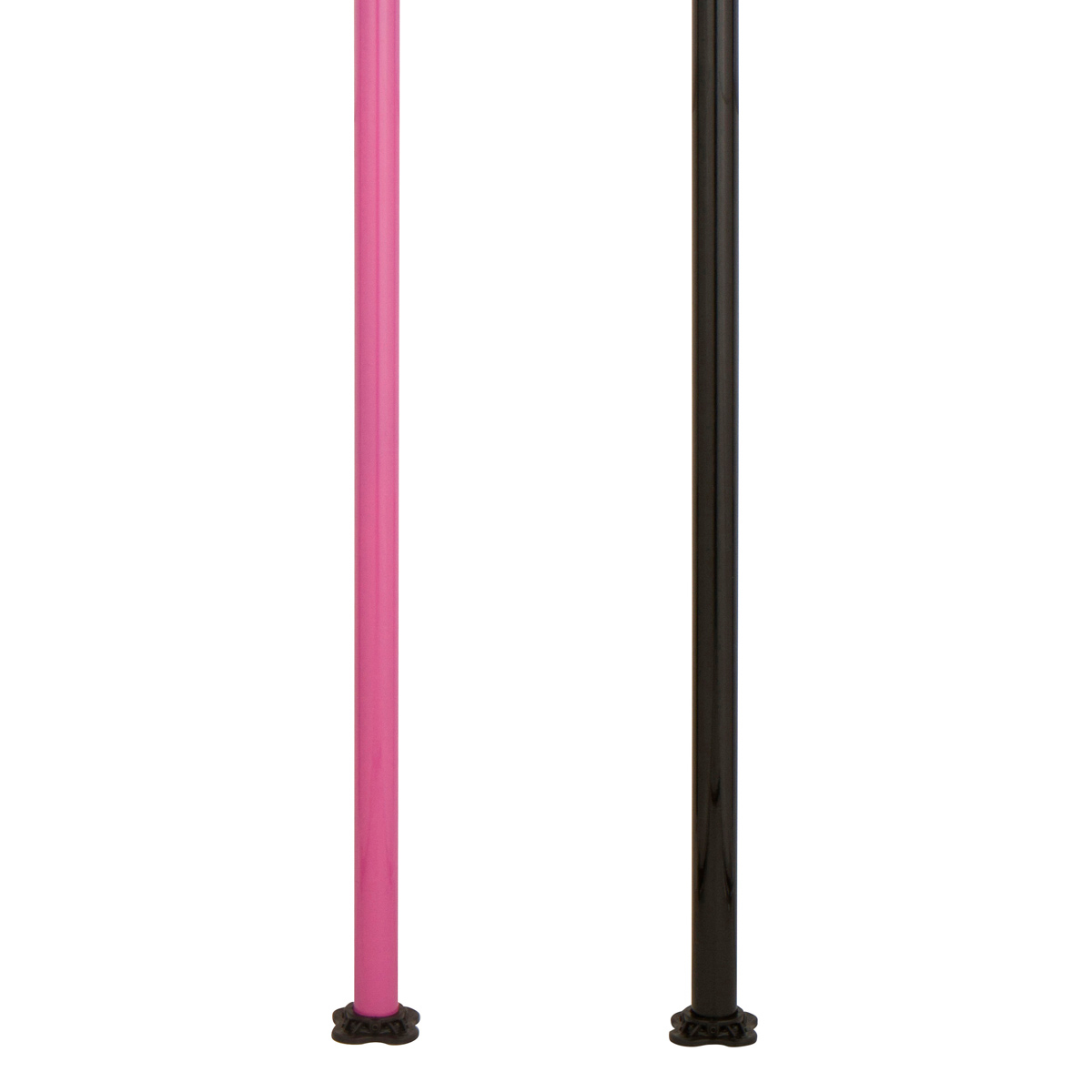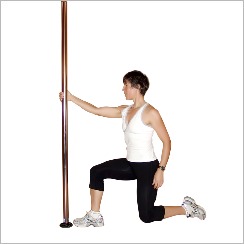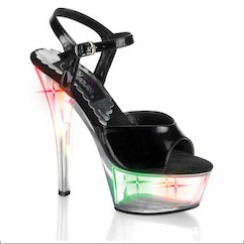Best Poles For Plus Size Pole Dancers
Home > Plus Size Info > Plus Size Poles
Plus size pole dancers, rejoice! You can join in the fun AND feel safe and confident on your dance pole.
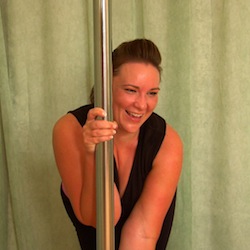 Plus size pole dancers, rejoice!
Plus size pole dancers, rejoice!Many people have general questions about the different dance poles available today, and which one is best for their needs.
Often, the deciding factor is portability, installation method, or choice of color or material.
But many large women who'd like to start pole dancing have special concerns about the safety of the different poles available, particularly in regards to weight limits.
Your Pole Pal often gets questions from heavier women wondering if a particular pole will be strong enough for them, or even whether they should buy one at all.
This page is filled with information to help allay your fears, provide reliable information, and to assist you in finding the best equipment for your needs, regardless of your size or weight.
Let's do this by looking at some of the factors that plus
size pole dancers may want to consider when shopping for a dance pole.
These factors include:
- Thickness of the pole wall
- Diameter of the pole
- Type of material used
- One piece vs multi-piece
- Installation method
The information below covers each of these considerations in detail.
Tubing Thickness
The first thing to think about is the thickness of the metal used to construct the pole. We're not talking about diameter here, but rather the thickness of the wall of the metal tubing.
A good quality pole like the Lil Mynx or the XPole will have a safe minimum thickness that is designed to carry a load. Thinner tubing is cheaper, but it won't take as much of a load as a pole made from a thicker walled tubing.
Most people don't consider this when shopping around, as it's not immediately obvious. But plus size pole dancers who are at all concerned about the weight limits of the different models should definitely ask about this.
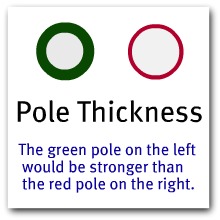 Thicker vs thinner tubing
Thicker vs thinner tubingMany of the cheaper models available, particularly some of the knockoffs made offshore, cut corners by using thinner metal. Stay away from these if you are concerned about maximum safety, as they are not going to take the same weight load as a higher quality product with a thicker wall.
Pole Diameter
The standard dance pole diameter used to be 2" (50 mm), but most manufacturers now offer at least one smaller diameter pole. Most of these are 1.75" (45 mm) but we're now seeing more poles available in a 1.5" (40 mm) diameter model too.
The smaller diameter (usually 1.75") is now being used as the standard in pole dance competition, and many contests and events specify this size. Partly for this reason, and partly because the 1.75" size is a better fit for many women's hands, more and more women are finding they prefer this smaller diameter option.
However, be aware that the smaller the diameter, the less strong the pole will be overall.
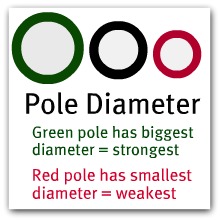 Larger diameter = stronger pole
Larger diameter = stronger poleDepending on your weight and how you intend to use your dance pole - for airborne tricks or strictly for floor-based moves - this may not be the make-or-break factor.
Still, all other things being equal, the safe weight load of a thicker diameter model is going to be higher.
Type of Material
The type of material used in the construction of your dance pole will also affect its strength. For example, brass is a softer metal than stainless steel or an alloy, so a brass pole will be inherently weaker than one made of stainless steel.
Be aware that there are some so-called "brass" models on the market that are not actually brass, but rather a brass look-a-like. Typically, these are plated steel and are therefore stronger than brass (though the durability of the coating is something else to consider again).
You can usually spot these imitation brass poles because the cost is much less than what you would expect to pay for brass. Not that there's anything wrong with them, however remember the rule of "buyer beware." It's up to you as the buyer to be sure you're getting what you think you're getting!
So if you have your heart set on a brass pole, be sure to ask if it's real brass before you buy. And if you're wanting to avoid brass in order to go with a stronger material, well you'll still want to ask, right?
In addition to brass, stainless steel, and plated steel (i.e. chrome), you can also get colored dance poles which are powder coated steel.
Lil Mynx sells these in two colors and in rotating and static models. Because steel is the base metal, they're going to be a stronger option than brass as well.
Keep in mind that all materials have their advantages and disadvantages, and many people also have a personal preference for say, brass over steel, or a powder coated finish over brass.
But plus size pole dancers may want to factor in the properties of the different materials that dance poles are made with, if they're concerned about the overall strength of the model they choose.
One Piece vs Multi-Piece
Another very important issue that plus size pole dancers may want to consider is whether to get a one piece or multi-piece dance pole.
Typically, the more seams and joints there are in a given pole, the weaker the overall construction will be.
This is because a solid, unbroken length of tubing has greater structural integrity than one that is made up of several pieces, and is therefore stronger.
So all other things being equal, a one piece pole is going to be stronger than a multi-piece pole.
 This X-Pole is an example of a multi-piece pole
This X-Pole is an example of a multi-piece poleHowever, there are additional factors to consider here, such as the height of the pole you're considering. The longer the length of tubing in general, the weaker it will be. This means that an 8' multi-piece pole may actually be stronger than a 10' one-piece pole (depending on other factors discussed above, such as the number of seams, thickness of the tubing, and the material used)
Also, consider how the pole goes together. A multi-piece model with
solid joints that screw together is going to be heavier, but certainly
stronger than one that simply slides or snaps together. (Are you starting to see that this is a bit more complicated than it appears at first glance?)
Installation Method
How your dance pole is installed has a lot to do with its willingness to stay vertical.
A permanently mounted pole is by far the most secure because it's screwed into both the floor and ceilings joists. Because of this, its ability to withstand a given weight load is very high.
On the other end of the scale, a friction fit model is the least secure in terms of installation, and accordingly, it would typically have a lower safe weight limit.
It isn't that a friction fit pole is inherently weaker, it's the installation method. This type of pole is more prone to coming down, regardless of the weight load, simply by virtue of its design. If you like, you can read more about friction fit pole safety here.
Other considerations
In addition to the five factors discussed above, here are a couple of other things plus size pole dancers may want to consider when thinking about which pole to purchase for home use.
Reinforcement
If you are considering a smaller diameter pole, it may be possible to have it reinforced. This is only possible with a permanently mounted pole mind you, but it may help to put your mind at ease.
Reinforcement is most likely to be needed with a very small diameter model (1.5"). Also, the longer your pole, the better idea it is to have it reinforced.
To provide this extra reinforcement, a solid steel rod slightly smaller than the diameter of your pole is inserted into the hollow outer tube before installation, providing additional strength and stability.
If you're purchasing a permanent dance pole, you can ask the
manufacturer about supplying a solid reinforcement for the interior. If this is not possible, or if the shipping cost is prohibitive (it will be heavy!) you may be able to purchase a length of solid tubing from a local metal supply shop or hardware store and install it yourself when you're ready to put your pole up.
Ease Of Installation
Something else for plus size pole dancers to think about is whether or not you're going to be able to do the installation on your own.
I don't mean to imply that you're not as strong as any other woman. In fact, chances are you're stronger than average. After all, if you're carrying extra weight, at least some of it is probably muscle, right?
It's just that sometimes, carrying extra weight comes with associated issues like joint disease or low back pain, which can hamper your ability to properly assemble and install your pole. For this reason, it's important to consider what type and brand might best meet any special needs or health concerns you have that are related to your weight.
For instance, a permanent pole only needs to be installed once. Even if you need a friend or family member to help you with the installation, once it's done it's done, and you won't need to worry about it again except for occasionally checking that all the screws are nice and tight.
On the other hand, a friction fit model or a removable dance pole needs more attention, even if you plan to leave it up for a period of time. For example, you really should be doing regular load tests, and you'll also need to get up on a ladder to check it for tightness. And if your pole does become loose, you'll need to be able to adjust and tighten it so it's safe once again.
So What's The Very Best Pole For Plus Size Pole Dancers?
When it comes to choosing the best pole for your needs, unfortunately there's not a one-size-fits-all answer. As a plus size pole dancer, you will need to weigh the above factors against your personal needs and preferences to arrive at a final decision on the best product for you.
For example, if you feel that a permanent dance pole is your best option, but you really want the convenience of a multi-piece portable model, you'll need to consider whether the flexibility advantages of the portable pole outweigh the safety advantages of the one that stays securely installed on a permanent basis.
Remember, as a plus size pole dancer you CAN enjoy this exciting form of fitness. Just do your research and give some thought to your needs and priorities so you'll feel confident about the equipment you purchase, and you'll soon be on your way to enjoying plenty of vertical fun and fitness.
If you need more information before making a decision, here are a few recommended pages for further reading...
Pole Reviews
If you're doing dance pole research, don't miss these in-depth reviews. Making the right choice just got easier!
Safety Tips
Hey you! Stay safe up there! Get the scoop on dance pole safety, injury prevention, important safety gear and lots more.
Types of Poles
If you're confused about the difference between a friction mount and a portable pole, or if you're just not sure where to start, this page is for you.
